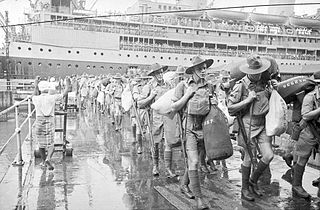
The 8th Division was an infantry division of the Australian Army, formed during World War II as part of the all-volunteer Second Australian Imperial Force. The 8th Division was raised from volunteers for overseas service from July 1940 onwards. Consisting of three infantry brigades, the intention had been to deploy the division to the Middle East to join the other Australian divisions, but as war with Japan loomed in 1941, the division was divided into four separate forces, which were deployed in different parts of the Asia-Pacific region. All of these formations were destroyed as fighting forces by the end of February 1942 during the fighting for Singapore, and in Rabaul, Ambon, and Timor. Most members of the division became prisoners of war, waiting until the war ended in late 1945 to be liberated. One in three died in captivity.
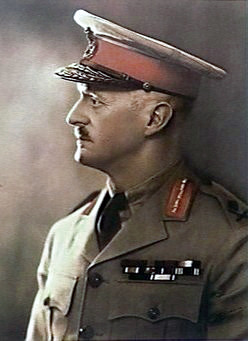
Lieutenant General Henry Gordon Bennett, was a senior Australian Army officer who served in both World War I and World War II. Despite highly decorated achievements during World War I, during which he commanded at both battalion and brigade level and became the youngest general in the Australian Army, Bennett is best remembered for his role during the fall of Singapore in February 1942. As commander of the 8th Australian Division, he escaped while his men became prisoners of the Imperial Japanese Army. After this, Bennett's military career waned and, although he rose to command a corps, he never again commanded troops in battle. In 1945, his escape caused controversy and resulted in a Royal Commission and military enquiry. Both found that he had been unjustified in relinquishing his command.

The fall of Singapore, also known as the Battle of Singapore, took place in the South–East Asian theatre of the Pacific War. The Japanese Empire captured the British stronghold of Singapore, with fighting lasting from 8 to 15 February 1942. Singapore was the foremost British military base and economic port in South–East Asia and had been of great importance to British interwar defence strategy. The capture of Singapore resulted in the largest British surrender in its history.

The Japanese 25th Army was an army of the Imperial Japanese Army during World War II, noted for its role in the Malayan Campaign and the Battle of Singapore.

The 2/18th Battalion was an Australian Army infantry unit that served during World War II. Formed in June 1940, the battalion was assigned to the 22nd Brigade, which formed part of the Australian 8th Division. After completing basic training, the 2/18th was sent to Singapore and Malaya to strengthen the defences of the British colonies in February 1941 against a possible Japanese attack. The 2/18th Battalion subsequently undertook garrison duties throughout the year at various locations in Malaya, where it conducted jungle training and constructed defences along the eastern coast.
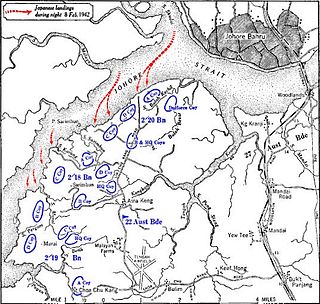
The Battle of Sarimbun Beach was the first stage of the Japanese assault on Singapore in February 1942 during World War II. Sarimbun Beach, in the northwestern corner of mainland Singapore, was the area in which Japanese troops, under the direction of Lieutenant-General Tomoyuki Yamashita, first attacked Allied forces in Singapore. The commander of all Allied forces in Singapore, Lieutenant-General Arthur Percival, did not expect the Japanese to make their main attack on the island from the northwest and subsequently failed to reinforce the 22nd Australian Brigade, which took the brunt of the Japanese assault. The main Japanese objective to be attained following their landing at Sarimbun Beach was the capture of Tengah Airfield.

The 2/30th Battalion was an infantry battalion of the Australian Army that served during World War II. Raised in late 1940 as part of the all volunteer Second Australian Imperial Force, the battalion formed part of the 27th Brigade, which was assigned to the 8th Division. In mid-1941, the battalion was deployed to Malaya, as the garrison there was increased amidst rising tensions in the Pacific. In early1942, it fought against the Japanese during the Malayan Campaign and the Battle of Singapore, where it was captured in February 1942. Many of the 2/30th's personnel died in captivity before the war ended in August 1945.

The 2/40th Battalion was an infantry battalion of the Australian Army. Formed in mid-1940 from personnel recruited from Tasmania, the battalion was assigned to the 23rd Brigade, which formed part of the 8th Division. After completing basic training, the 2/40th was sent to Darwin to form part of the defensive garrison there as tensions with the Japanese grew throughout 1941. Following Japan's entry into the war, the battalion was deployed to Timor as part of Sparrow Force and in early 1942 they took part in the fighting on the island against the Japanese. Outnumbered and lacking supplies, the majority of the 2/40th's personnel were captured and spent the rest of the war as prisoners of war, although some were able to wage a guerrilla campaign across the island before being withdrawn by the end of year.
The 27th Brigade was a brigade-sized infantry unit of the Australian Army. The brigade was the last Second Australian Imperial Force infantry brigade raised for service during World War II. Initially assigned to the 9th Division, the brigade was transferred to the 8th Division shortly after it was raised. Training was undertaken around Bathurst, New South Wales throughout early 1941, before the brigade was sent to British Malaya in August 1941 to reinforce the 22nd Brigade, which had been dispatched earlier in the year. Following the Japanese invasion of Malaya, the brigade went into action in January 1942, taking part in the fighting along the western side of the Malay Peninsula. Its main action during this period came around Muar before the withdrawal to Singapore. In February, the brigade took part in the short lived Battle of Singapore. When the garrison surrendered on 15 February, the majority of the brigade's personnel were taken prisoner. They subsequently spent the remainder of the war in captivity before being released in August 1945.

The 22nd Brigade was a brigade-sized infantry unit of the Australian Army. It was briefly raised in 1912 as a Militia formation providing training as part of the compulsory training scheme. Later, during World War II, the brigade was raised as part of the all volunteer Second Australian Imperial Force in April 1940. Assigned to the 8th Division, in early 1941 the brigade was deployed to British Malaya, where it formed part of the defensive garrison that was established there by the British, eventually establishing its headquarters in the Mersing–Endau area.

The 2/26th Battalion was an infantry battalion of the Australian Army. Raised in late 1940 for service during the Second World War, the battalion undertook garrison duties in Malaya and Singapore prior to the start of the Pacific War. In 1941–42, following the Japanese invasion of Malaya, the battalion fought during the Malayan campaign. After the fall of the island, however, many of its soldiers became prisoners of war, remaining in captivity until being liberated at the end of the war in 1945. The battalion was never re-raised.

The 2/4th Machine Gun Battalion was an Australian Army unit raised for service with the all volunteer Second Australian Imperial Force during the Second World War. Formed in late 1940 as part of the 8th Division, the battalion was established to provide direct fire support to the division's infantry brigades. It was the fourth, and last, such unit raised within the 2nd AIF. The unit's personnel were largely drawn from the state of Western Australia and after formation, the battalion concentrated near Perth for basic individual training before moving to the Adelaide Hills to complete more advance manoeuvres.
The 2nd Malaya Infantry Brigade was a regular infantry brigade formed in 1940 with its headquarters in Singapore following the wartime expansion and reinforcement of Malaya Command. The Brigade participated in the Malayan Campaign and the Battle of Singapore against the Japanese until the surrender of the garrison in February 1942.
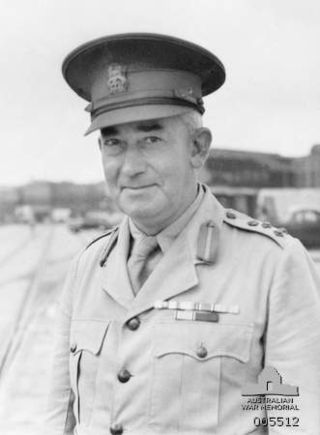
Brigadier Harold Burfield Taylor, was an analytical chemist and an Australian Army officer who served in the First and the Second World Wars. A junior officer in the First World War, during the Second World War he was commander of the 22nd Infantry Brigade during the Japanese invasion of Malaya. Captured along with many of his fellow soldiers following the fall of Singapore, he spent the remainder of the war as a prisoner of war. In civilian life, he was an analyst for the government and an expert in poisons, often called upon to give evidence in criminal trials involving poisoning.

The 2/29th Battalion was an infantry battalion of the Australian Army, which served during the Second World War. Formed in October 1940, the battalion served in Malaya as part of the 27th Brigade, which was assigned to the 8th Division. Recruited mainly from volunteers drawn from the state of Victoria, after completing its training around Bonegilla and then Bathurst, the 2/29th Battalion was sent to Malaya in August 1941 along with the rest of the 27th Brigade to bolster the Australian force there and subsequently fought in the Malayan Campaign following the Japanese attack in December 1941. The battalion fought several delaying actions along the west coast, including fighting around Bakri and Muar, and in Johore, before Allied forces withdrew across the Causeway to Singapore. The battalion later took part in the defence of Singapore in February 1942, but was captured after the garrison capitulated on 15 February. They spent the remainder of the war as prisoners of war, with many dying in captivity.

The 2/19th Battalion was an infantry battalion of the Australian Army, which was raised for service during the Second World War as part of the Second Australian Imperial Force. After being formed in mid-1940, the battalion was allocated to the 22nd Brigade, which was part of the 8th Division. After completing training in Australia, in early 1941 the 2/19th deployed to Malaya, as part of the Australian force despatched to help bolster the British garrison there as tensions with Japan heightened. Following the commencement of hostilities against Japan, the 2/19th fought several actions in Johore, before withdrawing across the Causeway to Singapore. There, the battalion was involved in the Battle of Singapore in early February 1942, during which it suffered heavy casualties before being captured following the capitulation of the British garrison. The battalion's personnel subsequently spent the next three-and-a-half years as prisoners of war, before being released at the end of the conflict.
The 2/15th Field Regiment was an Australian Army field artillery regiment that served during the Second World War. Raised in late 1940 as part of the Second Australian Imperial Force, the regiment was assigned to the 8th Division. In late 1941, it was sent to Singapore and subsequently fought in the Malayan Campaign before being captured after the Fall of Singapore.
The 2/21st Battalion was an infantry battalion of the Australian Army. Raised for service during Second World War as part of the Second Australian Imperial Force, it was formed on 11 July 1940 at Trawool in central Victoria as part of the 23rd Brigade of the 8th Division. It was subsequently deployed to Ambon as part of Gull Force in December 1941 following the Japanese invasion of Malaya; however, with the defence of the island considered untenable due to the limited military resources available and overwhelming Japanese strength it was subsequently captured despite determined resistance, surrendering on 3 February 1942. Most members of the battalion became prisoners of war, and a large number died in captivity.

The 2/10th Field Regiment was an Australian Army artillery regiment formed in mid-1940 as part of the Second Australian Imperial Force during World War II. The regiment was deployed to Malaya in 1941, taking part there in the military actions against the Japanese, and then deployed to Singapore in early 1942. When the garrison was surrendered, the majority of the regiment were taken prisoner and remained in captivity until the end of the war in August 1945.
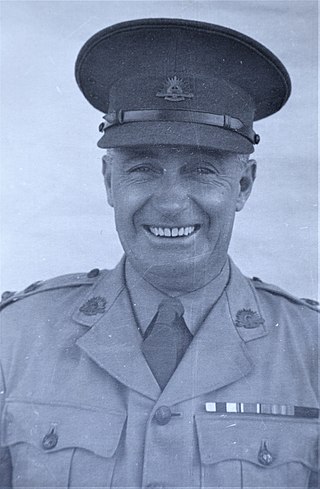
Lieutenant Colonel John Charles Robertson was a senior officer in the Australian Army who served in both the First and Second World Wars.


















